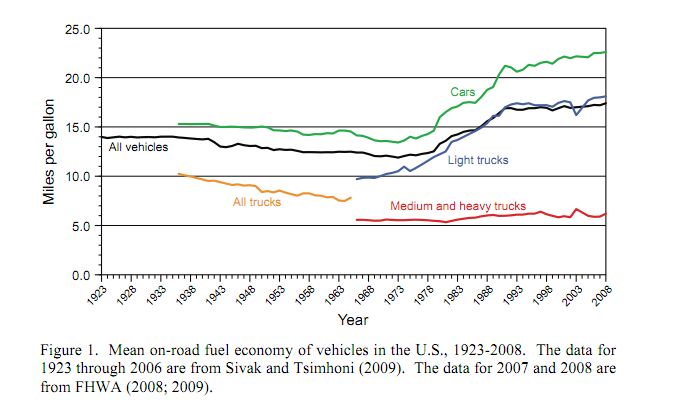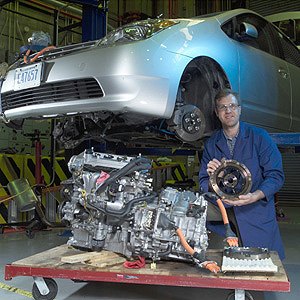#FuelEconomy
Fisker's Sticker Shock: 32 Miles On Electricity, 20 MPG On Range Extender
The Chevy Volt’s best news in ages broke yesterday when GreenCarReports, er, reported that the Fisker Karma had received EPA approval at 32 miles of EV range, and 20 MPG (combined) thereafter. Moreover, the MPGE (the “e” is for “equivalent”) rating of 52 on electric power is nearly half the Volt’s 94 MPGE rating, suggesting that the Karma is not the most efficient car even in EV mode. And, at nearly 5,600 lbs (per evo.co.uk), you don’t have to look far to find out why. But if you ask Fisker, the problem isn’t the car… the problem is those darn EPA numbers, which you should probably just ignore anyway. After all, nobody drives less efficiently than their car’s EPA numbers, right?
European Market Volt Gets EV-Only "Hold Mode," Should The US Version?
In an era of increasingly-globalized automobiles, the “market-to-market adjustments” which modify a global vehicle to “local tastes” are becoming an interesting source of insight into a company’s perspective. And Chevrolet Europe boss Wayne Brannon revealed one of the more significant adjustments in recent memory (because nobody reads the press releases), when he told Automotive News [sub]’s Dave Guilford
I just switch it into extended range mode, and I drive on fuel until I get there. When I drive in the little villages and towns, I drive in electric mode.
The reason it was important here is we have cities — like London — where you don’t have to pay a congestion charge if you’re running purely on battery. You save the battery for when you need it.
Gosh, that’s an interesting idea. It would certainly help clear up some of the confusion in the marketplace about why the Chevy Volt is the way it is. Imagine the tagline: “Gas or electric? You decide.” So, how about it, GM? Will that feature come to the US?
Fuel Economy: It's Your Problem Too
A University of Michigan study [ PDF] shows that, in the 85 years between 1923 and 2008, average on-road fuel economy in the US has improved a mere 3.5 MPG. In fact, the study shows that driving a car is even more energy-intensive (per occupant-mile) than flying on an airplane (3,501 BTU per mile versus 2,931 BTU per mile). Some will blame weak government regulations for this unimpressive result, but the study found that the convenient government scapegoat is not completely to blame.
This report presents information about the effects of decisions that a driver can make to influence on-road fuel economy of light-duty vehicles. These include strategic decisions (vehicle selection and maintenance), tactical decisions (route selection and vehicle load), and operational decisions (driver behavior).
The results indicate that vehicle selection has by far the most dominant effect: The best vehicle currently available for sale in the U.S. is nine times more fuel efficient than the worst vehicle. Nevertheless, the remaining factors that a driver has control over can contribute, in total, to about a 45% reduction in the on-road fuel economy per driver—a magnitude well worth emphasizing. Furthermore, increased efforts should also be directed at increasing vehicle occupancy, which has dropped by 30% from 1960. That drop, by itself, increased the energy intensity of driving per occupant by about 30%
Could Fuel Efficiency Save Racing?
With Audi and Peugeot dominating the last several Le Mans races using diesel technology to outlast the competition, it seems that the famous French race is becoming the premiere stage for developing and highlighting the latest fuel-saving technology. And why not? Most marketing of new fuel-saving technology highlights the preserved performance and enhanced reliability as much as pure energy savings alone. And leadership in this suite of attributes is about to receive a little more competition, as Toyota announces that
In 2012, Toyota will take part in several races of the FIA World Endurance Championship, including the Le Mans 24 Hours, with a prototype “LMP1” car featuring a gasoline-electric hybrid powertrain.
Get Hyundai on board, and bring BMW’s new i brand into the mix, and the international racing business could be re-energized by the competition to demonstrate the perfect compromise between performance, reliability and efficiency. As many of the top racing series see declines in viewers and manufacturer participation due to their increasing irrelevance to mass-market vehicles and brands, the golden age of endurance racing could just be dawning.
Steel Industry: Replace Tailpipe Emissions Testing With Lifecycle Analysis
Light-weight materials such as carbon-fiber, aluminum and magnesium are widely touted as key components of the drive towards greater fuel economy. Which explains why the automotive steel supplier industry is suddenly calling for an end to tailpipe emissions testing and a switch to the more holistic life cycle analysis testing. According to a press release from WorldAutoSteel, an industry group, the production of steel alternatives can create up to 20 times the carbon emissions of steel.
Chevy-Dealing Congressman: "There Is No Market" For The Volt
In addition to being a representative from Pennsylvania, Republican Mike Kelly is also a Chevrolet dealer whose family has sold Chevys since 1953. But in recent hearings on government fuel economy ratings, he laid into his brand’s green halo car, the Chevy Volt with surprising zeal. Or, not-so-surprising, when you realize that he decided to run for congress in the wake of the bailout-era dealer cull.
I’m a Chevrolet dealer… we have a Chevy Volt on the lot, it’s been there now for four weeks. We’ve had one person come in to look at it, just to see what it actually looks like… Here’s a car that costs $45,763. I can stock that car for probably a year and then have to sell it at some ridiculous price. By the way, I just received some additional information from Chevrolet: in addition to the $7,500 [federal] tax credit, Pennsylvania is going to throw another $3,500 to anybody foolish enough to buy one of these cars, somehow giving them $11,000 of taxpayer money to buy this Volt.
When you look at this, it makes absolutely no sense. I can stock a Chevy Cruze, which is about a $17,500 car and turns every 30 to 40 days out of inventory… or I can have a Volt, which never turns and creates nothing for me on the lot except interest costs… So a lot of these things that we’re seeing going on have a tremendous economic impact on people who are being asked to stock them and sell them. There is no market for this car. I do have some friends who have sold them, and they’re mostly to people who have an academic interest in it, or municipalities who are asking to buy these cars.
With dealers like that, who needs competitors? Seriously, Kelly even says he fired the guy who ordered a Volt for his dealership… which he then counts against the Volt’s job creation record. Hit the jump for the rest of his quote.
Anwyl: CAFE Proposals "Ignore Consumers" Who Are "Not On Board"
The Congressional Subcommittee on Regulatory Affairs, Stimulus Oversight and Government Spending held hearings this week on proposed CAFE standards, as part of Chairman Darryl Issa’s investigation of the regulations. The first panel’s testimony can be seen in its entirety in the video above (all prepared testimony can be found in PDF format here), and it’s worth watching. Though the predictable D.C. partisanship certainly shows up, Anwyl’s testimony was the highlight the hearing, being a tough but fair analysis of the standards. Hit the jump for a brief roundup.
Veloster Turbo Makes Its Video Debut
Michael Karesh may have been one of the few writers to review the Hyundai Veloster without the expectation of a truly sporting drive, but even he concludes that
Those who insist on go with their show needn’t despair, only patiently wait for the turbo Hyundai’s not yet talking about.
Because Hyundai’s European executives started talking about a turbo version prior to the launch date, and Hyundai Motor America still rolls its eyes at the mere mention of a turbo Veloster, I wasn’t optimistic. But between a recent explosion of US-based spy shots of Veloster Turbo mules (both in Death Valley and near HATCI in Michigan) and a 210 HP ARK Performance-tuned Veloster Turbo heading to SEMA, I’m beginning to share Karesh’s opinion that the Veloster Turbo is an inevitability for the US market. Besides, Hyundai has earned a little fuel-burning frivolity: its year-to-date combined full-fleet fuel economy (CAFE) is 35.9 MPG, just over the 2015 standard of 35.5 MPG.
Ask The Best And Brightest: What Is Obama's "130 MPG" Battery?
When the blogging gets tough, the tough bloggers get outsourcing, and since we’re swamped with fresh news and sales numbers, I’m going to throw this little mystery over to you, TTAC’s Best and Brightest. It’s no secret that the Obama Administration is bullish on plug-in cars, as it seeks to put a million of the fuel-efficient vehicles on the road by 2015. And though several studies have shown that the White House’s goal is wildly overambitious and needs more money or a major spike in gas prices, and though even the DOE’s assessment shows that the goal is unrealistic, EV optimism springs eternal. So, whence cometh this profound, unshakeable belief that the EV is going to go from production-constrained curiosity to significant market player in just a few years?
EPA Inspector General Questions GHG Emissions Science, Issa Attacks On All Fronts
In a report released earlier this week [ PDF], the EPA Inspector General criticized the Technical Support Document for the portion of greenhouse gas regulation dealing with “Endangerment,” or the possible effects of greenhouse gasses. Inspector General Arthur A. Elkins Jr. summed up his office’s findings [ PDF], writing
The OIG evaluated EPA’s compliance with established policy and procedures in the development of the endangerment finding, including processes for ensuring information quality. We concluded that the technical support document that accompanied EPA’s endangerment finding is a highly influential scientific assessment and thus required a more rigorous EPA peer review than occurred. EPA did not certify whether it complied with OMB’s or its own peer review policies in either the proposed or final endangerment findings as required. While it may be debatable what impact, if any, this had on EPA’s finding, it is clear that EPA did not follow all required steps for a highly influential scientific assessment. We also noted that documentation of events and analyses could be improved.
Oy vey. Greenhouse gas science controversy. So, what’s the problem really about?
White House Delays CAFE Announcement As Jobs, Downsizing Achievments Come Under Fire
Though the Obama Administration has announced the broad outlines of its 2017-2025 CAFE standard, the final rule wasn’t supposed to be released until the end of this week… and now, according to Reuters, it is delaying that release until mid-November. According to Reuters
The administration would, with a short delay, remain on track to meet its deadline for issuing final rules next July, five years before they take effect. That timeline gives the industry room to plan its vehicle mix and make any production or technology changes…
But sources familiar with the matter said the work is complex and time consuming. Regulators, they said, are purposely moving slower than anticipated to ensure that industry, environmental and consumer issues likely to be raised during a lengthy public comment period are addressed ahead of time.
Regulators also want to make sure the proposal can clear the White House budget office, which reviews proposed regulations, in a timely fashion.
But even as regulators work to anticipate criticisms of the new standard, more criticisms are materializing. From the mitigating impact of loopholes added late in the process to the regulation’s effect on jobs, the CAFE criticisms are stacking up.
Review: 2012 Chevrolet Cruze ECO
With the Cruze, Chevrolet has pulled off a rare combination: segment-leading sales (up 31 percent from last year) at a higher transaction price (up 27 percent from two years ago to $20,465, according to TrueCar). But it hasn’t hurt that the Corolla, Civic, Focus, and Elantra have all been supply constrained. Once competitors get their factories running, does the Cruze have what it takes to maintain its current lead?
Americans Love Tiny Cars, They're Just Not Aware Of Them
Under Penske management, the Smart minicar brand sold fewer than 6,000 vehicles last year, capping a sales decline that led Mercedes to take back management duties for the brand. And, according to the new folks in charge of Smart, there’s only one real problem with the brand: awareness. Or, more precisely, lack thereof. We’ve heard this song before from Smart’s new GM, but now Ernst Lieb, boss of Mercedes U.S.A., is picking up the tune, telling Automotive News [sub] that
With the marketing activities that we’re going to have, we’ll see some positive momentum. The biggest problem the car has right now: Nobody knows it.
Which, of course, is nonsense. Nonsense that allows you to appear aware of the sales problem without acknowledging a single problem with the product itself, but nonsense none the less. And Smart’s not the only micro-car brand that’s reaching for it either, as Fiat-Chrysler marketing boss Olivier Francois has the exact same excuse for Fiat’s weak start, telling AdAge
I don’t think we have a car problem; people love the car. I think we have an awareness problem.
Are Americans incapable of seeing, recognizing or being aware of anything that weighs less than 3,000 lbs? Or is it possible that there are a few things wrong with the Smart and 500?
Roses Are Red, Hybrids Are Green… Except When They're Tuned For Power, Not Efficiency
From all the hype it gets, you would think hybrid technology is intrinsically green—and many Americans, including some policy-makers actually believe that. The Union of Concerned Scientists’ (UCS) new hybrid scorecard lays that canard to rest.
Wild-Ass Rumor Of The Day: After The Ridgeline, Honda Considering An Even Smaller Pickup?
In a blog item bemoaning the likely imminent death of the Honda Ridgeline, Automotive News [sub] Product Editor Rick Kranz accuses Honda of “abandoning” its funky pickup by failing to update its styling or hardware since it was introduced in 2005. His point seems to be that the Ridgeline was a decent enough niche product that withered on the vine… and the sales numbers certainly seem to support that thesis. But if you compare Ridgeline to other Japanese-brand compact-midsized pickups, you find that Toyota and Nissan saw similar drops in volume over a similar time period… as did practically all non-full-size pickups. So could Honda have done more for the Ridgeline, or was its decline inevitable? While you’re pondering that mystery, consider this: Kranz points to the last sentence of a months-old piece for one of those zombie rumors that never really got any play:
Based on conversations with industry sources, the story said a smaller pickup is under consideration, derived from the CR-V platform.
Presuming less payload and towing capacity than the Ridgeline, I can’t imagine why a smaller pickup based on a front-drive platform would be a more successful product formula for Honda.
On the other hand, a CR-V-based pickup is something that hasn’t been tried for decades in this market… and it wouldn’t compete nearly as directly with the cheap full-sizers that are killing the “compact” (actually midsized) pickups. So, is Kranz’s logic sound, or could a CR-V-based pickup mix up the market? Faith springs eternal for me when it comes to efficient utility vehicles… but what say you?






















Recent Comments